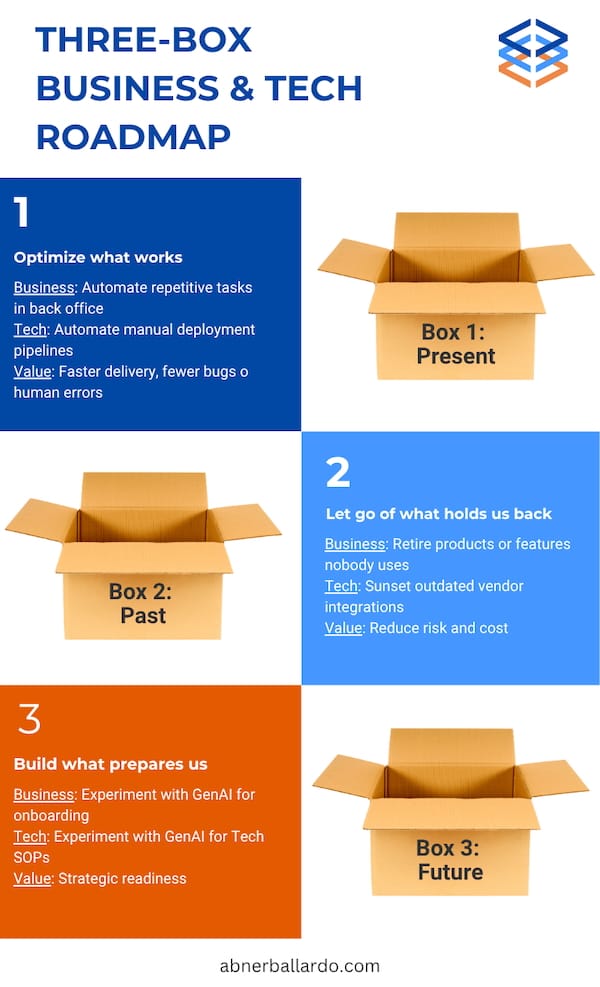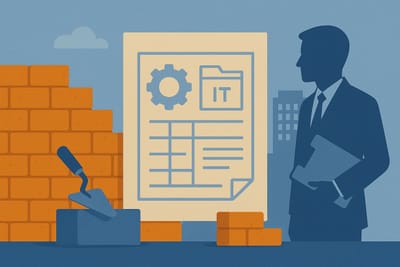Building a Business-Aligned Technology Roadmap

Why Tech-Business Alignment Is Hard—But Essential
In the early days of a fintech I worked with, our roadmap was airtight: timelines, milestones, technical initiatives. But six weeks in, business priorities shifted due to changes in the market and local and international crises. Suddenly, our beautiful roadmap felt like an expensive mirage.
This is the reality most tech leaders face. Business evolves faster than architecture. Decisions are made without understanding the ripple effects on infrastructure, scalability, or security. And the result? Frustration, wasted work, and missed opportunities.
In this article, I want to share why alignment is hard, how to fix it, and how both business and tech leaders can co-create roadmaps that evolve with purpose.
The Root Problem: Tech Is Still Treated as a Black Box
In both startups and traditional organizations, C-level leaders often struggle to interpret technology. Roadmaps are either too technical or too disconnected from reality. And when unexpected changes hit—which they always do—it becomes painfully clear that:
- Business teams don’t grasp tech constraints.
- Tech teams don’t understand shifting priorities.
- Roadmaps live in silos.
We need a shared language. A system that brings transparency, agility, and collaboration.
What Is a Business-Aligned Technology Roadmap?
A technology roadmap is not a wishlist of tools. It’s a living plan that guides how technology evolves to serve the business.
- Product roadmap: Focuses on value delivery through features and experiences.
- Technology roadmap: Focuses on the architecture, infrastructure, and internal capabilities that enable that value.
To be business-aligned, your roadmap must:
- Be rooted in strategic goals (growth, cost, speed, compliance).
- Reflect current tech debt and future readiness.
- Acknowledge real-world constraints: people, budget, velocity.
- Be visible and adaptable by both tech and business leaders.
The Core Components of a Resilient Roadmap
Every solid technology roadmap I’ve worked with includes:
- Business objectives: Know what the company is trying to achieve.
- Tech initiatives: Mapped to outcomes, not just platforms.
- Prioritization logic: Why this, why now?
- Capacity view: What can we actually deliver, with current people and partners?
- Anti-roadmap: What we are not doing, and why.
A Simple Framework: The Three-Box Roadmap
Inspired by Vijay Govindarajan’s "Three-Box Solution," this is how I frame roadmap balance:

If your roadmap is only in Box 1, you’re efficient but not evolving. If you don’t have anything in Box 2, your technology and processes are getting fat with old stuff. Too much in Box 3? You risk vaporware. The goal is balanced progression.
The Hard Part: Prioritization Under Constraints
Stakeholders will always push for more. But your job is to explain trade-offs clearly:
- Business value vs. architectural integrity
- Quick wins vs. long-term health
- Speed vs. risk exposure
To do this, I use repetition and simplification. One time I explained microservices to a board using Legos. They got it. Use whatever artifact works—Gantt charts, visual frameworks, even analogies.
Real-World Lessons: Two Stories
🔹 Facebook Messenger + Open Banking API (Success)
While leading a digital team at a Peruvian bank, we were building a money transfer feature for Facebook Messenger. I architected the APIs with Open Banking principles, drawing from BBVA and BIAN. Just before launch, Facebook canceled the project.
It could’ve been a total loss. But because we aligned the tech with broader trends, we pivoted quickly. Those same APIs became the foundation for our Open Banking platform. Business saw the foresight. Tech saved the investment.
❌ Ignored Mainframe Exit Strategy (Failure)
In another bank, I recommended a gradual exit from core banking mainframes. The idea was dismissed. Years later, they’re now paying the cost: delays, lock-in, talent scarcity.
Lesson: If you don’t align long-term tech vision with business realities, someone will pay for that delay—eventually.
Making It Stick: Communicating and Iterating
A roadmap is not a document. It’s a dialogue. Review it every six months. Tie it to OKRs, retros, and leadership sessions. Keep it visible. Keep it flexible.
Train your business counterparts. Bring them into the architecture room. And help them understand that technology is not magic—it’s designed under constraint.
Final Reflection
If you’re a CTO, architect, or founder, remember this:
Every architectural decision is a business decision.
Your roadmap is your voice. It shapes how your organization invests, learns, and adapts. Don't let it be just a technical plan. Make it a strategic contract between business and technology.
No spam, no sharing to third party. Only you and me.






Member discussion